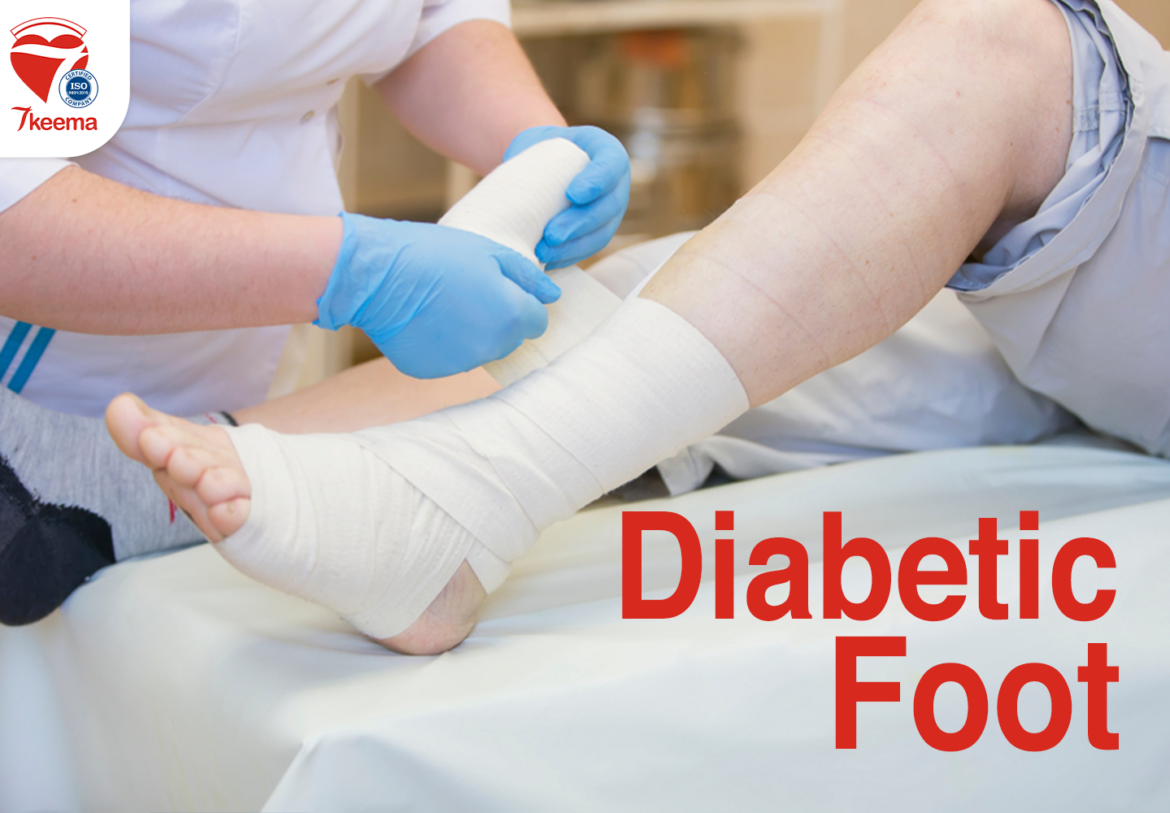Symptoms, causes, and how to treat.
So many people around the world are suffering from diabetes, which is caused by high or low glucose levels in the blood.
As much as it could be properly controlled and the patient would live a normal life, as much as it could lead to some severe complications.
One of these complications is the Diabetic Foot.
A diabetic patient could face some serious problems due to his condition. That’s why, we are going to discuss the Diabetic Foot subject through this article, to know how to overcome it.

Diabetic Foot Symptoms:
To get the full image, we should first learn how to diagnose it. Knowing that symptoms could vary from one patient to another due to many factors that affect it. Let’s spread out the symptoms:
Loss of feeling in the foot
A major symptom is to start not feeling pain in your foot.
This is not good as it sounds, but the patient wouldn’t know he’s even injured for a long time, which could lead to wound infection due to bacteria.
Moreover, a diabetic foot patient wouldn’t also feel high temperature, which could result in skin burns and foot distortion.
– Pain and Dry Skin:
Foot skin would start getting dry, which lead to cracks and massive pain, due to nerve damage.
Poor blood circulation:
Which affects the wound healing process, due to blood vessel malfunction.
– Corns:
A layer of hard skin starts to build up near a bony area of a toe or between toes. This could happen due to boot pressure that rubs against toes.
– Foot Sores:
Or Diabetic ulcers, which is a deep sore or crack in the foot or ankle skin that could be infected and healed slowly.
Diabetic ulcers are a consequence of clogged arteries that reach out the foot. Up to 10% of diabetes patients would suffer foot ulcers.
– High Skin Temperature:
Diabetes could cause vessel malfunction, with an increase in the foot skin temperature accompanied by acupuncture pain in the foot.
– Gangrene:
Foot skin tissues start to die gradually and cause gangrene, due to poor blood circulation, or bacterial infection.
– Amputation:
This is the last stage, and in some cases, it is a must to avoid even some more complications.
However, you can get to know more about wound care in general through this link.

Diabetic Foot Causes:
Diabetic foot is a consequence of several causes. It happens mainly when foot nerves get malfunctioned when glucose levels increase in the blood. Therefore, here’re the main reasons for Diabetic foot.
– Vascular Diseases:
Diabetes affects the fatty deposits outside the brain and heart, which cause low blood circulation to the feet.
– High Cholesterol:
High cholesterol level in the human body is the main cause of clogged arteries, which will block normal blood circulation to feet.
– Foot Hygiene:
Not taking care of the foot hygiene would cause Diabetic Foot, due to bacteria and fungus infections.
– Smoking:
In general, smoking is a bad habit that affects your health in so different ways.
But when you’re a diabetes patient, the risk is doubled.
Smoking is the main cause of poor blood circulation and clogged arteries, which are by their turn the main cause of Diabetic Foot.
– Excessive Obesity:
High weights put too much pressure on the feet, which affects normal blood circulation and could cause Diabetic Foot.
– Suitable Boots:
It’s very important to wear suitable boots, to avoid high pressure and high friction against feet.
– Burns and Bruises:
A diabetes patient should be very careful to avoid burns and bruises, which could lead to severe wounds hard to be healed.

Prevent from Diabetic Foot:
It’s always better to prevent than treat.
If you’re a diabetes patient, it’s easy to prevent getting a Diabetic Foot.
– Foot Hygiene:
Always make sure your feet are clean and dry, to avoid any bacterial or fungus infection. Also, keep your feet warm while sleeping by wearing suitable socks.
– Daily Check:
Check every day that you are not suffering any abnormal symptoms in your feet and that you can feel toes and skin normally. Otherwise, go check a doctor.
– Cut Nails:
Also to avoid fungus infection, you should cut your nails periodically.
– Suitable Boots:
Make sure to always wear suitable boots.
To make your feet comfortable, not pressured, and well ventilated. Tight boots are not helping in wound healing and getting normal blood circulation.






